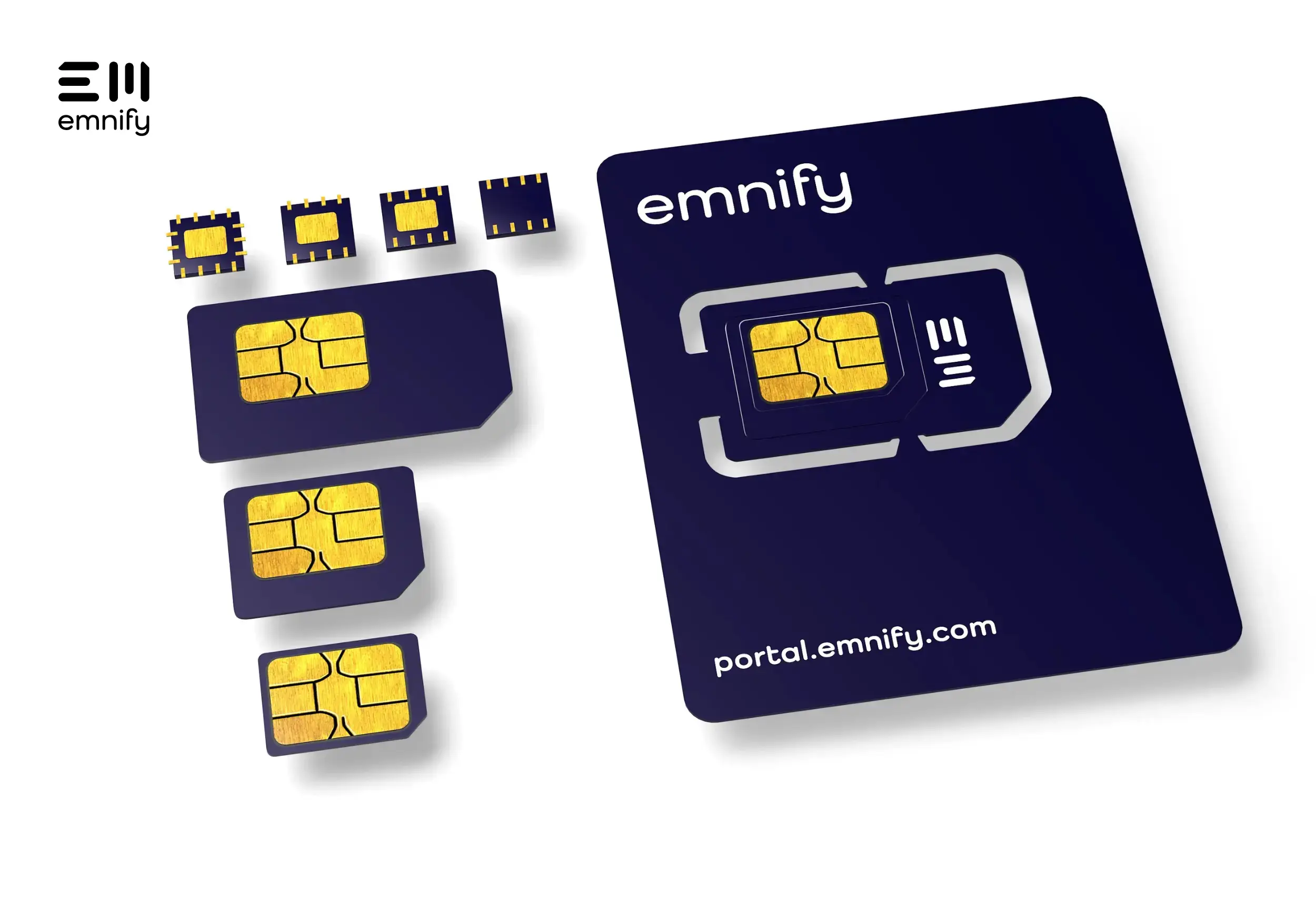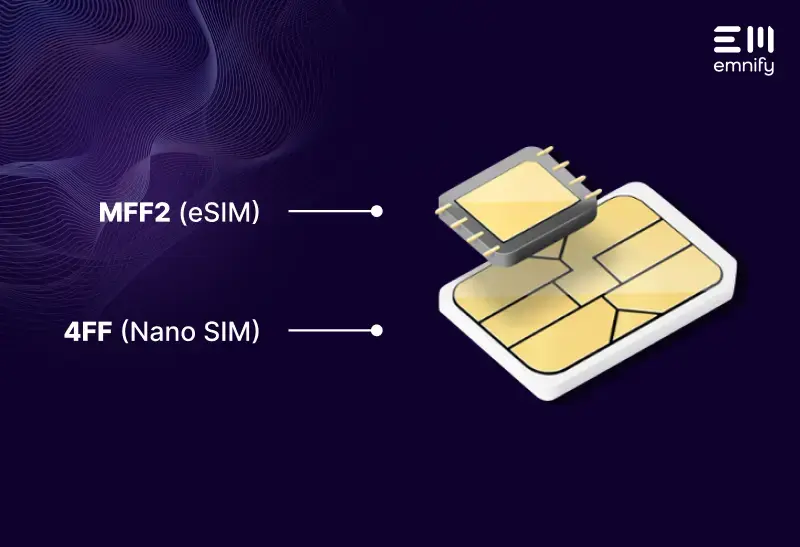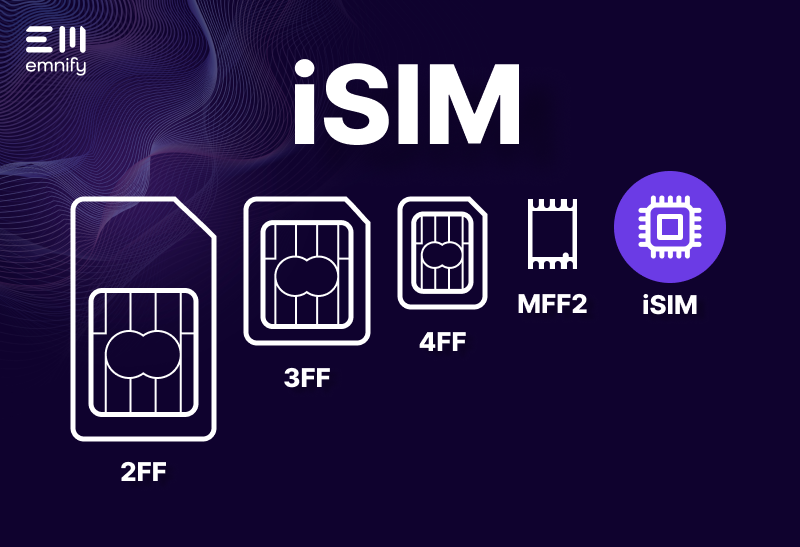

Quick definition: A SIM, or Subscriber Identity Module, is a small memory chip that is either inserted into or built into a device, providing it with the ability to connect to a cellular network. SIM cards, which can be non-updatable UICCs or updatable eUICCs (commonly known as eSIMs), are available in various form factors and types, such as standard SIMs, eSIMs, and iSIMs.
The humble SIM card has evolved far beyond its original design, becoming a critical component in ensuring ongoing connectivity across devices and networks globally. From the traditional, physical SIMs to the innovative, embedded SIMs, the technology has adapted to meet the diverse and expanding needs of IoT applications.
In this article, we take a brief look into the world of SIM technologies, exploring their types, form factors, and the vital role they play in shaping the IoT landscape.
Difference between types of SIMs and SIM form factors
Before we look at the variety of SIM cards available, it’s important to distinguish between SIM types and SIM form factors.
‘SIM types’ refers to the card’s functionality and technological features, with variations including standard SIMs, and embedded SIMs (eSIMs).
Conversely, ‘SIM form factors’ refer to the physical dimensions of the SIM card, which include traditional sizes like Full-Sized, Mini, Micro, and Nano SIMs, as well as embedded form factors like MFF2 and USON8.
A SIM card’s type is not tied to its form factor—a nano SIM can be an eSIM, and an eSIM can come in different form factors, such as MFF2.
iSIMs represent another form factor, eliminating the need for a physical card altogether.
Types of SIMs

Several SIM card types have emerged, and the most prominent ones include:
Standard SIMs
Standard SIMs are the classic version of SIM cards, stored in a physical plastic card that can be transferred between devices such as mobile phones and tablets. These cards come with their own set of specific limitations.
Unlike more advanced SIM technologies, specifically eSIMs, they do not allow the SIM profile to be remotely changed or configured, meaning network settings or updates must be manually performed.
Embedded SIMs/eUICCS (eSIMs)
The eUICC, or Embedded Universal Integrated Circuit Card, and eSIM (Embedded SIM) often intertwine but serve distinct roles when it comes to connectivity.
While an eSIM refers to a physical embedded SIM card that does not require a tray or slot in the device, eUICC refers to the software that enables the remote provisioning of carrier profiles on the eSIM. An eSIM is available in various form factors, including 4-in-1, 3-in-1, and MFF2.
The eUICC software on eSIMs allows for the remote management and swapping of carrier profiles, ensuring that the sensors maintain reliable connectivity with optimal network providers, regardless of geographical location, without necessitating physical intervention. This capability to acquire a new profile, akin to a software update, even enables a change in the service provider, offering unparalleled flexibility in managing global IoT deployments.
Take, for instance, an IoT deployment in agriculture, where numerous sensors are embedded across vast farmlands to monitor environmental conditions. While standard SIMs can connect to multiple network providers, they are bound to the SIM profile set during production.
In contrast, eUICC technology, especially when sensors are deployed globally and interact with various network providers and technologies, provides a distinct advantage by offering the flexibility to remotely manage and swap carrier profiles.
While eSIM provides the physical framework for embedded connectivity, eUICC offers the technological capability to manage this connectivity remotely and flexibly across various network providers and regions.
Multi-IMSI technology
Multi-IMSI (International Mobile Subscriber Identity) technology stands out as a connectivity solution. Unlike traditional SIMs that are confined to a single IMSI, Multi-IMSI SIMs are pre-loaded with multiple IMSIs, each corresponding to a different network carrier. This enables the SIM to switch between various network providers, enhancing the reliability of connectivity, especially in cross-border or remote deployments.
For instance, in a global IoT deployment involving asset tracking across multiple countries, a Multi-IMSI SIM can seamlessly switch between different carrier networks as the asset moves, ensuring uninterrupted data transmission.
It's crucial to highlight that while Multi-IMSI provides flexibility in network selection by switching between pre-loaded profiles, it does so with the unique advantage of making decisions locally on the SIM, without requiring connectivity.
On the other hand, eSIM technology allows carrier profiles to be remotely provisioned and managed via eUICC software, offering a distinct kind of flexibility.
However, it’s worth noting that embedded SIMs, especially those with eUICC, encounter a challenge: if you need to switch a carrier due to lack of connectivity in a specific country, you cannot update the embedded SIM as it requires connectivity to manage it.
Thus, while eSIMs provide a high degree of flexibility and remote manageability in dynamic IoT deployments, Multi-IMSI SIMs offer a true solution for maintaining connectivity in scenarios where remote management is not feasible.
SIM form factors
You could say the differences between SIMs start with the form factor. SIM cards come in various shapes and sizes, and these form factors don’t necessarily determine what kind of software the SIM will have implemented.
Full-Size SIM (1FF)
Comparable in size to a credit card, this is the oldest and the largest card and was predominantly used for early-generation car phones, but advancements in miniaturization technology have now made this form factor redundant.
Mini SIM (2FF)
 While Mini SIM cards, also known as 2FF SIMs, may be considered dated, they continue to find relevance, particularly in certain IoT devices. For instance, 2G-based GPS trackers often utilize the 2FF form factor. The 2FF SIM’s ongoing use in such applications highlights its durability and the technology’s ability to serve specific needs even as the industry continues to evolve.
While Mini SIM cards, also known as 2FF SIMs, may be considered dated, they continue to find relevance, particularly in certain IoT devices. For instance, 2G-based GPS trackers often utilize the 2FF form factor. The 2FF SIM’s ongoing use in such applications highlights its durability and the technology’s ability to serve specific needs even as the industry continues to evolve.
Micro SIM (3FF)
 The Micro SIM, or 3FF SIM, emerged with the advent of smartphones and devices requiring even smaller components. Its compact size allowed device manufacturers to devote more space to other elements like larger batteries or additional circuitry. This in turn advanced smartphone capabilities such as longer battery life and improved performance.
The Micro SIM, or 3FF SIM, emerged with the advent of smartphones and devices requiring even smaller components. Its compact size allowed device manufacturers to devote more space to other elements like larger batteries or additional circuitry. This in turn advanced smartphone capabilities such as longer battery life and improved performance.
Nano SIM (4FF)
![]() The Nano SIM, or the 4FF SIM, is currently the smallest plastic SIM card available, where the plastic and the chip are nearly identical in size. While the 4FF is the tiniest among plastic SIM cards, MFF2 embedded SIMs also present themselves as compact physical form factors, albeit integrated directly into the device’s circuitry. The Nano SIM design reflects the ongoing trend toward miniaturization, enabling even thinner and more feature-rich devices.
The Nano SIM, or the 4FF SIM, is currently the smallest plastic SIM card available, where the plastic and the chip are nearly identical in size. While the 4FF is the tiniest among plastic SIM cards, MFF2 embedded SIMs also present themselves as compact physical form factors, albeit integrated directly into the device’s circuitry. The Nano SIM design reflects the ongoing trend toward miniaturization, enabling even thinner and more feature-rich devices.
Embedded SIM (eSIM/MFF2)
![]() The eSIM, or MFF2, represents a significant shift away from physical SIM cards. MFF2 eSIMs can be bought on reels from providers like emnify and then soldered onto the device, offering a secure connectivity solution.
The eSIM, or MFF2, represents a significant shift away from physical SIM cards. MFF2 eSIMs can be bought on reels from providers like emnify and then soldered onto the device, offering a secure connectivity solution.
Integrated SIM (iSIM)
![]() The iSIM, or integrated SIM, diverges from the concept of a physical form factor. The iSIM is not a physical SIM card; it’s part of the wireless chipset in every modem and is loaded directly onto it. This integration is particularly beneficial for smaller, low-power devices where accommodating the physical components of an embedded SIM might be challenging.
The iSIM, or integrated SIM, diverges from the concept of a physical form factor. The iSIM is not a physical SIM card; it’s part of the wireless chipset in every modem and is loaded directly onto it. This integration is particularly beneficial for smaller, low-power devices where accommodating the physical components of an embedded SIM might be challenging.
Another benefit is that it has no SIM hardware or logistics, which ultimately leads to lower costs. It’s crucial to note that the iSIM isn’t designed to replace the embedded SIM but rather to offer an alternative solution, catering to different use cases while still ensuring global, future-ready technology.
A quick note on architecture standards
ICC: The ICC standard, once a staple of IoT connectivity, is long outdated and generally out of use. It’s exclusively tethered to GSM and 2G, so you’re unlikely to come across it when choosing SIM cards for your IoT system.
UICC: This is the most widely used SIM software standard as it compatible with a number of networks -- GSM/2G, 3G, 4G, 5G, LTE Cat 1 bis, and LTE-M and NB-IoT. However, UICC cards can only hold one operator profile, making them prone to issues with permanent roaming and achieving broad global coverage.
eUICC: eUICC is software on the SIM card that allows for the remote provisioning of carrier profiles. eUICC can be used on all SIM form factors (2FF to MFF2 embedded SIMs), but having an embedded SIM (eSIM) doesn’t guarantee that you have eUICC, and vice versa.
The emnify global IoT eSIM
Navigating global IoT deployments presents a unique set of challenges, particularly in managing connectivity across diverse geographical locations and network technologies. The emnify global IoT eSIM is a transformative solution and is specifically designed to navigate and simplify global IoT connectivity by addressing several key aspects:
- Reliable Connectivity: The IoT eSIM is equipped with a multi-IMSI applet, ensuring robust connectivity across the globe at cost-effective rates.
- Regulatory Adherence: It includes features like the Brazil IMSI, ensuring compliance with regional regulatory requirements, such as those specific to Brazil.
- Future-Proofing: The IoT eSIM is updateable, ensuring it can adapt to the latest configurations and future emnify enhancements, such as potential satellite connectivity integrations.
The emnify global IoT eSIM offers unified connectivity with a single profile and APN, integrating all RANs into our single, logical core network. Whether utilizing an emnify SIM in Germany with T-Mobile, or in Australia with Telstra, all data traverses through our core network, embodying a truly network-agnostic approach. This approach not only sidesteps the need to predict regional device usage but also empowers you with insights and access to monitor all devices – globally and in real-time.
Our CEO, Frank Stoecker, describes this succinctly: “The new emnify IoT eSIM is not just about tapping into SIM capabilities that we didn’t have before – it’s transforming the way IoT connectivity is delivered.”
Built with Multi-IMSI and eUICC technology, the emnify global IoT eSIM simplifies the complexity of achieving network access, ensuring resilient global coverage, navigating evolving network technologies, and managing complex logistics processes for your IoT deployments with a single eSIM. Available as eUICC in all form factors - 2FF, 3FF, 4FF, and MFF2, and in the future, also as iSIM - the emnify eSIM is ready to adapt and evolve with the ever-changing landscape of cellular connectivity.
Navigating the future of IoT with advanced SIM technology
From the traditional, physical SIM cards to the innovative, remotely manageable eSIMs and iSIMs, the journey of SIM technology has been significant, adapting to the needs of diverse IoT applications. Looking ahead it is safe to assume that the continuous evolution of SIM technology will undoubtedly sculpt the trajectory of IoT deployments, driving enhanced connectivity, scalability, and operational efficiency across myriad applications and industries.
Get in touch with our IoT experts
Discover how emnify can help you grow your business and talk to one of our IoT consultants today!

With a career spanning over 18 years in storytelling and content creation, Bronwyn translates technical concepts and ideas into snackable and easy-to-digest content.


